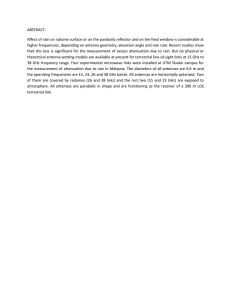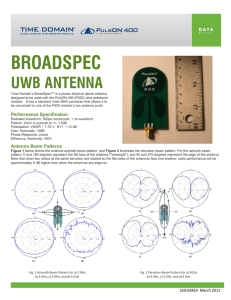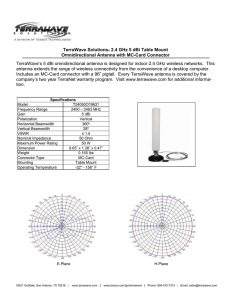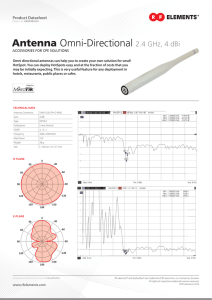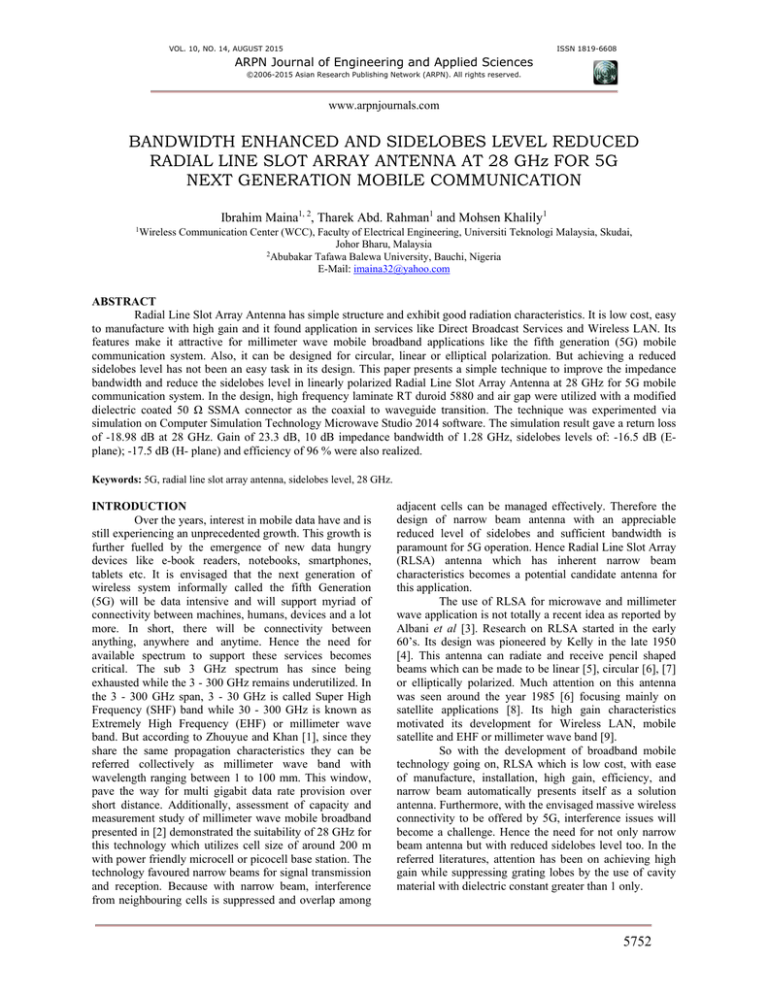
VOL. 10, NO. 14, AUGUST 2015
ISSN 1819-6608
ARPN Journal of Engineering and Applied Sciences
©2006-2015 Asian Research Publishing Network (ARPN). All rights reserved.
www.arpnjournals.com
BANDWIDTH ENHANCED AND SIDELOBES LEVEL REDUCED
RADIAL LINE SLOT ARRAY ANTENNA AT 28 GHz FOR 5G
NEXT GENERATION MOBILE COMMUNICATION
Ibrahim Maina1, 2, Tharek Abd. Rahman1 and Mohsen Khalily1
1Wireless
Communication Center (WCC), Faculty of Electrical Engineering, Universiti Teknologi Malaysia, Skudai,
Johor Bharu, Malaysia
2Abubakar Tafawa Balewa University, Bauchi, Nigeria
E-Mail: imaina32@yahoo.com
ABSTRACT
Radial Line Slot Array Antenna has simple structure and exhibit good radiation characteristics. It is low cost, easy
to manufacture with high gain and it found application in services like Direct Broadcast Services and Wireless LAN. Its
features make it attractive for millimeter wave mobile broadband applications like the fifth generation (5G) mobile
communication system. Also, it can be designed for circular, linear or elliptical polarization. But achieving a reduced
sidelobes level has not been an easy task in its design. This paper presents a simple technique to improve the impedance
bandwidth and reduce the sidelobes level in linearly polarized Radial Line Slot Array Antenna at 28 GHz for 5G mobile
communication system. In the design, high frequency laminate RT duroid 5880 and air gap were utilized with a modified
dielectric coated 50 Ω SSMA connector as the coaxial to waveguide transition. The technique was experimented via
simulation on Computer Simulation Technology Microwave Studio 2014 software. The simulation result gave a return loss
of -18.98 dB at 28 GHz. Gain of 23.3 dB, 10 dB impedance bandwidth of 1.28 GHz, sidelobes levels of: -16.5 dB (Eplane); -17.5 dB (H- plane) and efficiency of 96 % were also realized.
Keywords: 5G, radial line slot array antenna, sidelobes level, 28 GHz.
INTRODUCTION
Over the years, interest in mobile data have and is
still experiencing an unprecedented growth. This growth is
further fuelled by the emergence of new data hungry
devices like e-book readers, notebooks, smartphones,
tablets etc. It is envisaged that the next generation of
wireless system informally called the fifth Generation
(5G) will be data intensive and will support myriad of
connectivity between machines, humans, devices and a lot
more. In short, there will be connectivity between
anything, anywhere and anytime. Hence the need for
available spectrum to support these services becomes
critical. The sub 3 GHz spectrum has since being
exhausted while the 3 - 300 GHz remains underutilized. In
the 3 - 300 GHz span, 3 - 30 GHz is called Super High
Frequency (SHF) band while 30 - 300 GHz is known as
Extremely High Frequency (EHF) or millimeter wave
band. But according to Zhouyue and Khan [1], since they
share the same propagation characteristics they can be
referred collectively as millimeter wave band with
wavelength ranging between 1 to 100 mm. This window,
pave the way for multi gigabit data rate provision over
short distance. Additionally, assessment of capacity and
measurement study of millimeter wave mobile broadband
presented in [2] demonstrated the suitability of 28 GHz for
this technology which utilizes cell size of around 200 m
with power friendly microcell or picocell base station. The
technology favoured narrow beams for signal transmission
and reception. Because with narrow beam, interference
from neighbouring cells is suppressed and overlap among
adjacent cells can be managed effectively. Therefore the
design of narrow beam antenna with an appreciable
reduced level of sidelobes and sufficient bandwidth is
paramount for 5G operation. Hence Radial Line Slot Array
(RLSA) antenna which has inherent narrow beam
characteristics becomes a potential candidate antenna for
this application.
The use of RLSA for microwave and millimeter
wave application is not totally a recent idea as reported by
Albani et al [3]. Research on RLSA started in the early
60’s. Its design was pioneered by Kelly in the late 1950
[4]. This antenna can radiate and receive pencil shaped
beams which can be made to be linear [5], circular [6], [7]
or elliptically polarized. Much attention on this antenna
was seen around the year 1985 [6] focusing mainly on
satellite applications [8]. Its high gain characteristics
motivated its development for Wireless LAN, mobile
satellite and EHF or millimeter wave band [9].
So with the development of broadband mobile
technology going on, RLSA which is low cost, with ease
of manufacture, installation, high gain, efficiency, and
narrow beam automatically presents itself as a solution
antenna. Furthermore, with the envisaged massive wireless
connectivity to be offered by 5G, interference issues will
become a challenge. Hence the need for not only narrow
beam antenna but with reduced sidelobes level too. In the
referred literatures, attention has been on achieving high
gain while suppressing grating lobes by the use of cavity
material with dielectric constant greater than 1 only.
5752
VOL. 10, NO. 14, AUGUST 2015
ISSN 1819-6608
ARPN Journal of Engineering and Applied Sciences
©2006-2015 Asian Research Publishing Network (ARPN). All rights reserved.
www.arpnjournals.com
Therefore this paper presents a simple design to
realize an enhanced bandwidth and a reduced sidelobes
level in linearly polarized RLSA at 28 GHz for 5G mobile
communication system with a caveat that the antenna must
have a gain of at least 12 dB, 10 dB impedance bandwidth
of 1 GHz [10]. The remaining paper is organized as
follows: The conventional structure of the antenna was
first highlighted followed by brief explanation on how to
achieve the feed transition customization. The proposed
antenna design is then explained followed by results, conclusions and acknowledgment.
The conventional RLSA structure
The theory and design of RLSA with linear
polarization fed by disk ended feed probe have been
succinctly dealt with in [8], [11]. Its standard or
conventional form consist basically of two parallel plates
spaced a distance d. The upper plate contains the radiating
slots patterns and the lower plate acts as the ground. This
is pictorially shown in Figure-1.
g c / r r
where
and
g
c
r
wavelength in the guide
speed of light
relative permeability
The dielectric material create a slow wave in the
guide resulting in λg < λo (free space wavelength) to
prevent grating lobes from appearing in the radiation
pattern. It was recommended in [8] that ɛr must be greater
than 1 for that to be achieved. As shown in Figure-1, a
circle of radius ρmin around the feed probe is left devoid of
slots to allow the formation of axially symmetric traveling
wave. The slots are arrayed along the radial distance ρ
spaced Sᶲ and Sρ in azimuth and radial directions
respectively. The slot orientation and these separations are
controlled to space the slots in a defined distribution on
the radiating surface so that their radiation is added in
phase in the beam direction and also yield linear
polarization. The axially symmetric outward travelling
wave is launched into the guide by the rear center fed disk
ended dielectric coated coaxial to waveguide transition
feed probe. This ensures that only TEM mode propagate in
the radial cavity. And to realize uniform illumination over
the radiating surface according to [12] the slot length is
varied with respect to the radius ρmax of the radiating
surface according to the relation.
lrad 5.8678 6.415 10
3
9
12 10
(2)
fo
fo is the center frequency.
The slot then couples the wave in the desired
direction at the radiating surface. The radiating surface and
ground were made of copper plates.
Figure-1. Standard form of RLSA [12].
The space d which act as the radial waveguide is
usually filled with a dielectric material of suitable relative
permittivity (ɛr). d is restricted by the relation
d <
g
2
(1)
The feed transition
The feed transition utilized in this paper is a
dielectric coated 50 Ω SSMA connector modified with
disk ended head. This arrangement as used in previous
researches was found to effectively convert the signal
from TEM coaxial mode to the desired TEM cavity mode.
An amplified section of this transition in the standard form
design is shown in Figure-2. The choice of SSMA
(frequency handling range 100 MHz - 40 GHz) was
informed by the desired center frequency which is 28
GHz. With the ceiling placed on d by equation (1),
variables R (diameter of the disk head), a (height of air
space above the head), b (height of the disk head) and c
(height of air space below the head) need be optimized to
achieve the optimum performance. More analysis on this
type of transition can be found in [13].
5753
VOL. 10, NO. 14, AUGUST 2015
ISSN 1819-6608
ARPN Journal of Engineering and Applied Sciences
©2006-2015 Asian Research Publishing Network (ARPN). All rights reserved.
www.arpnjournals.com
Figure-2. Disk ended coaxial to waveguide transition.
Proposed antenna structure
The frequencies of applications were RLSA was
given much attention enumerated in the literatures allowed
for almost a centimeter value of d to be used and achieving
low sidelobes level has not been of major concern. But for
the application in question here, the need to have low
sidelobes level and the corresponding value of d makes it
difficult to achieve an optimum and acceptable
customization with the conventional design structure. To
simplify the design, the concept of using air gap layer in
antenna structure as presented in [14], [15] and [16] was
adapted. The concept was demonstrated for RLSA with
FR4 laminate utilizing none disk ended dielectric coated
50 Ω SMA connector at 26 GHz [17] and 5.8 GHz [18]
with success. In this paper, the idea was extended to
include a disk ended 50 Ω dielectric coated SSMA probe
and RT duroid 5880 high frequency laminate. The air gap
is formed between the ground and the RT duroid 5880
board all having rectangular shapes while the radiating
surface with circular dimension sits on top of the board.
With such arrangement, the manufacturing process was
further eased. In addition, the use of rectangular shaped
cavity and ground in the proposed design was to have a
well aligned structure. The disk ended feed probe post was
made to resides completely within the air gap. CST
perspective of the design is shown in Figure-3. To achieve
optimum performance, we optimize only R and b.
RESULTS
Both the conventional and the proposed designs
were simulated. Likewise air gapped with none disk ended
design was also simulated. The specifications of the
parameter used are listed in Table-1. In the conventional
design, polypropylene was used as the cavity material.
Polypropylene was used because it was favoured for most
of the RLSA designs in the literatures. R, a, d and c were
set to be 2.6 mm, 0.3 mm, 1.5 mm and 1.2 mm
respectively (the best for the arrangement). For the air gap
design, RT duroid 5880 of thickness 0.254 mm with
dielectric constant 2.2 was used along with air gap of 2.5
mm. The dimension for the air gap was born from the
desire to achieve a low overall dielectric constant for the
cavity while not violating the restriction on d. For the
proposed design with parameters given in Table-1, the
overall cavity dielectric constant was found to be 1.12.
The simulation results are as shown in Figures 4 to 9.
Table-1.The specification of the simulated antennas.
Parameter
Value
Centre frequency fo
28 GHz
Cavity thickness(Maximum) d
3.0 mm
Radius of antenna
50 mm
No. of slots in first ring
18
Thickness of radiating surface (copper)
0.1 mm
Thickness of ground (copper)
Relative permittivity of RT duroid 5880
Polypropylene
1.0 mm
2.2
2.4
The S-parameter results for the optimization of
the proposed design is shown in Figure-4. The best
performance was observed with b = 1.7 mm and R = 2.2
mm with S11 value of -18.98 dB at 28 GHz and a 10 dB
impedance bandwidth of 1.28 GHz at first instance.
(a) Front face
(b)
Side view
Figure-4. Simulated reflection coefficient of the proposed
air gap design with R = 2.2 mm and variable b.
Figure-3. CST perspective of the modified design.
5754
VOL. 10, NO. 14, AUGUST 2015
ISSN 1819-6608
ARPN Journal of Engineering and Applied Sciences
©2006-2015 Asian Research Publishing Network (ARPN). All rights reserved.
www.arpnjournals.com
To establish the optimum design point with b =
1.7 mm, different values of R were used as in Figure-5. It
was confirmed that the best performance is still with the
set R = 2.2 mm and b =1.7 mm.
Figure-7. Simulated reflection coefficient of the proposed
design and air gap none disk ended design.
Figure-5. Simulated reflection coefficient of the proposed
air gap design b = 1.7 mm with variable R.
For the conventional and the proposed designs,
the S-parameter results obtained were compared as shown
in Figure-6. The performance improvement both in term of
S11 and bandwidth for the proposed design can be clearly
seen. The conventional had a bandwidth of 0.92 GHz
which did not fulfil the bandwidth requirements for 5G as
mentioned before, while the proposed RLSA had a 10 dB
bandwidth of 1.28 GHz. To further confirm the claimed
improvement brought in by adding the disk head in the air
gap design, a none disk ended design as earlier mentioned
was simulated. Its result is depicted in Figure-7, where an
impedance bandwidth of only 0.28 GHz was observed.
This further reveals the suitability of the proposed design
for the target frequency band and application.
The achieved reduced sidelobes levels are
revealed from the E - and H - plane radiation patterns of
the conventional and modified design as shown in Figures
8 and 9. Sidelobes level of -16.5 dB, 3 dB half power
beam width of 7.5o and -17.5 dB, 3 dB half power beam
width of 7.5o were achieved in the E - and H - planes
respectively for the proposed as against -13.9 dB and -8.3
dB for the E - and H - planes in the conventional design.
Furthermore, the CST results showed that the antenna has
radiation efficiency of -0.1823 dB. Which means that the
proposed antenna has an efficiency of 96 %.
Figure-8. E -plane radiation pattern.
Figure-6. Simulated reflection coefficient of the proposed
design compared with the conventional design.
5755
VOL. 10, NO. 14, AUGUST 2015
ISSN 1819-6608
ARPN Journal of Engineering and Applied Sciences
©2006-2015 Asian Research Publishing Network (ARPN). All rights reserved.
www.arpnjournals.com
[3] M. Albani, A. Mazzinghi and A. Freni. 2012.
Automatic Design of CP-RLSA Antennas. Antennas
and Propagation, IEEE Transactions on. 60: 55385547.
[4] K. Kelly. 1957. Recent annular slot array
experiments. In 1958 IRE International Convention
Record. pp. 144-152.
[5] M. Ando, T. Numata, J. I. Takada and N. Goto. 1988.
A linearly polarized radial line slot antenna. Antennas
and Propagation, IEEE Transactions on. 36: 16751680.
Figure-9. H -plane radiation pattern.
CONCLUSIONS
A hybrid low profile air gap disk ended probed
linearly polarized RLSA was designed and simulated. The
simulations were carried out on Computer Simulation
Technology Microwave Studio 2014 platform. By
properly adjusting the critical design parameters, a
compact antenna with radius of 50 mm having enhanced
impedance bandwidth and reduced sidelobes level for
mobile broadband application at 28 GHz was realized
meeting all the supposed requirements for 5G antennas.
The air gap and the disk ended probe greatly improved the
return loss, the realized bandwidth, and the achieved low
sidelobes as compared to the conventional and the air
gapped with none disk ended probe designs. An acceptable
gain that surpass the limit set for 5G application was also
achieved while sidelobes levels in both E - and H - planes
were pushed down. All these suggest that the antenna can
suitably be used for mobile broadband applications like
the 5G.
ACKNOWLEDGEMENT
The authors are very grateful to the Malaysian
Ministry of Higher Education (MOHE), the Research
Management Centre (RMC), and the Wireless
Communication Center (WCC), Universiti Teknologi
Malaysia (UTM), under Research University Grants Vote
No. 01K29, HiCOE grant for supporting this study.
REFERENCES
[6] M. Ando, K. Sakurai, N. Goto, K. Arimura and Y. Ito.
1985. A radial line slot antenna for 12 GHz satellite
TV reception. Antennas and Propagation, IEEE
Transactions on. 33: 1347-1353.
[7] N. Goto and M. Yamamoto. 1980. Circularly
Polarized Radial Line Slot Antennas. IEICE
Technical Report. Vol. 57-80.
[8] P. W. Davis and M. E. Bialkowski. 1997.
Experimental investigations into a linearly polarized
radial slot antenna for DBS TV in Australia. Antennas
and Propagation, IEEE Transactions on. 45: 11231129.
[9] T. Purnamirza, T. A. Rahman and M. H. Jamaluddin.
2012. The Extreme Beamsquint Technique to
Minimize the Reflection Coefficient of Very Small
Aperture Radial Line Slot Array Antennas. Journal of
Electromagnetic Waves and Applications. 26: 22672276.
[10] F. Khan, P. Zhouyue and S. Rajagopal. 2012.
Millimeter-wave mobile broadband with large scale
spatial processing for 5G mobile communication. In
Communication, Control, and Computing (Allerton),
2012 50th Annual Allerton Conference on. pp. 15171523.
[1] Z. Pi and F. Khan. 2011. An introduction to
millimeter-wave
mobile
broadband
systems.
Communications Magazine, IEEE. 49: 101-107.
[11] J. I. Takada, M. Ando and N. Goto. 1992. A reflection
cancelling slot set in a linearly polarized radial line
slot antenna. Antennas and Propagation, IEEE
Transactions on. 40: 433-438.
[2] S. Rangan, T. S. Rappaport and E. Erkip. 2014.
Millimeter-Wave Cellular Wireless Networks:
Potentials and Challenges. Proceedings of the IEEE.
102: 366-385.
[12] P. W. Davis and M. E. Bialkowski. 1999. Linearly
polarized radial-line slot-array antennas with
improved return-loss performance. Antennas and
Propagation Magazine, IEEE. 41: 52-61.
5756
VOL. 10, NO. 14, AUGUST 2015
ISSN 1819-6608
ARPN Journal of Engineering and Applied Sciences
©2006-2015 Asian Research Publishing Network (ARPN). All rights reserved.
www.arpnjournals.com
[13] M. E. Bialkowski. 1991. Analysis of a coaxial-towaveguide adaptor incorporating a dielectric coated
probe. Microwave and Guided Wave Letters, IEEE. 1:
211-214.
[14] S. M. Shum and K. M. Luk. 1994. Characteristics of
dielectric ring resonator antenna with an air gap.
Electronics Letters. 30: 277-278.
[15] D. Guha and J. Y. Siddiqui. 2004. Resonant frequency
of equilateral triangular microstrip antenna with and
without air gap. Antennas and Propagation, IEEE
Transactions on. 52: 2174-2178.
[16] D. Bhardwaj, Komal, D. Bhatnagar and S. Sancheti.
2008. Square patch microstrip antenna with single
notch having an air gap. In Recent Advances in
Microwave Theory and Applications, 2008.
MICROWAVE 2008. International Conference on.
pp. 910-912.
[17] I. M. Ibrahim, T. A. Rahman, M. I. Sabran, U.
Kesavan and T. Purnamirza. 2013. Wide Band Open
Ended Air Gap RLSA Antenna at 26 GHz Frequency
Band. Progress in Electromagnetic Research
Symposium Proceedings. pp. 470-473.
[18] W. A. W. Muhamad, T. A. Rahman and M. F. Jamlos.
2013. The effects of air-gap on spider radial line slot
array (SRLSA) antenna for point to point application.
In Wireless Technology and Applications (ISWTA),
2013 IEEE Symposium on. pp. 388-390.
5757

